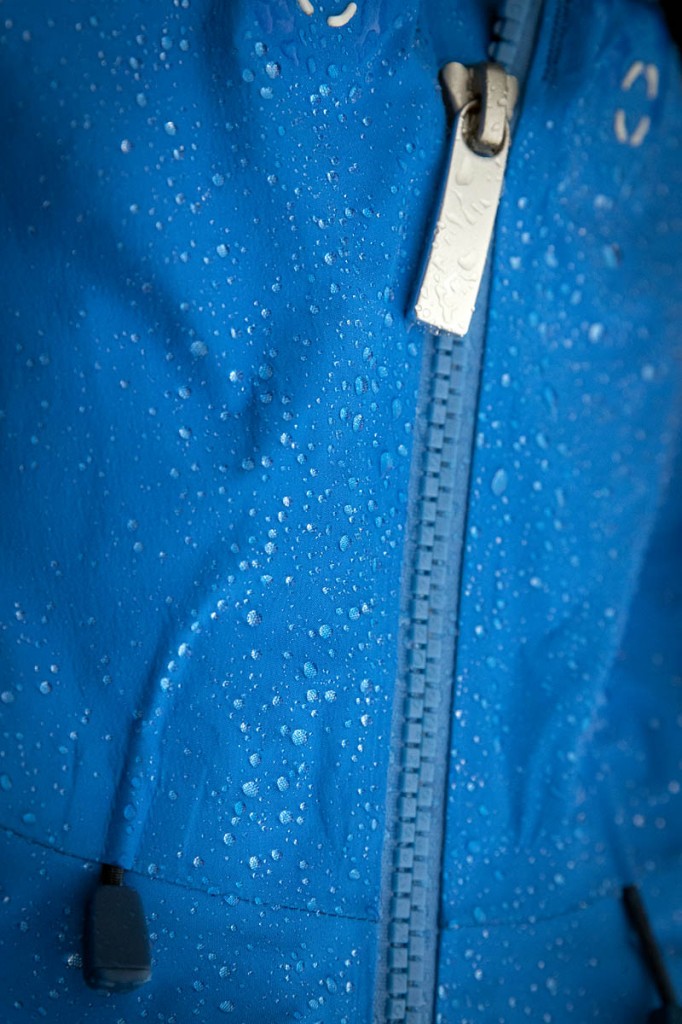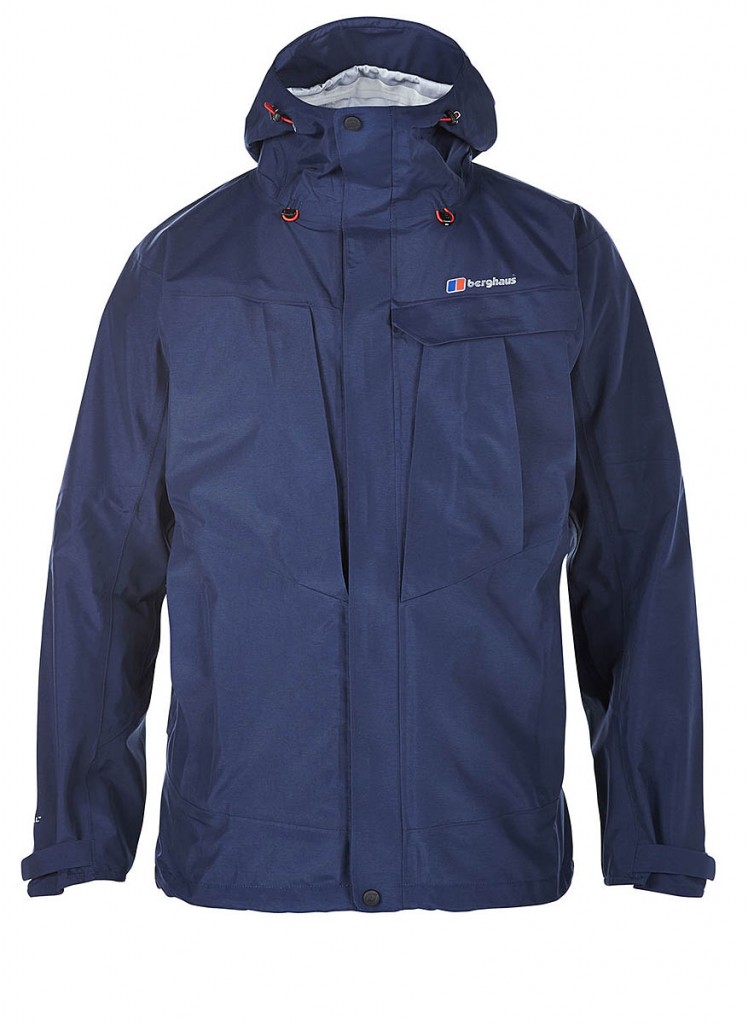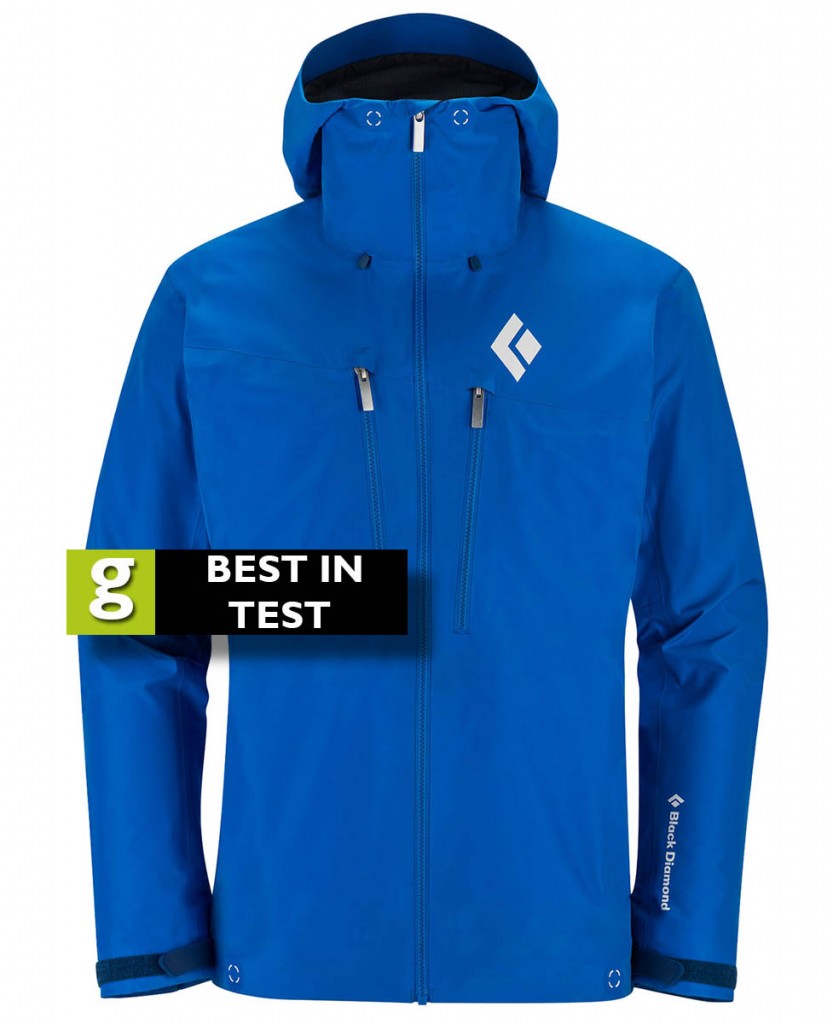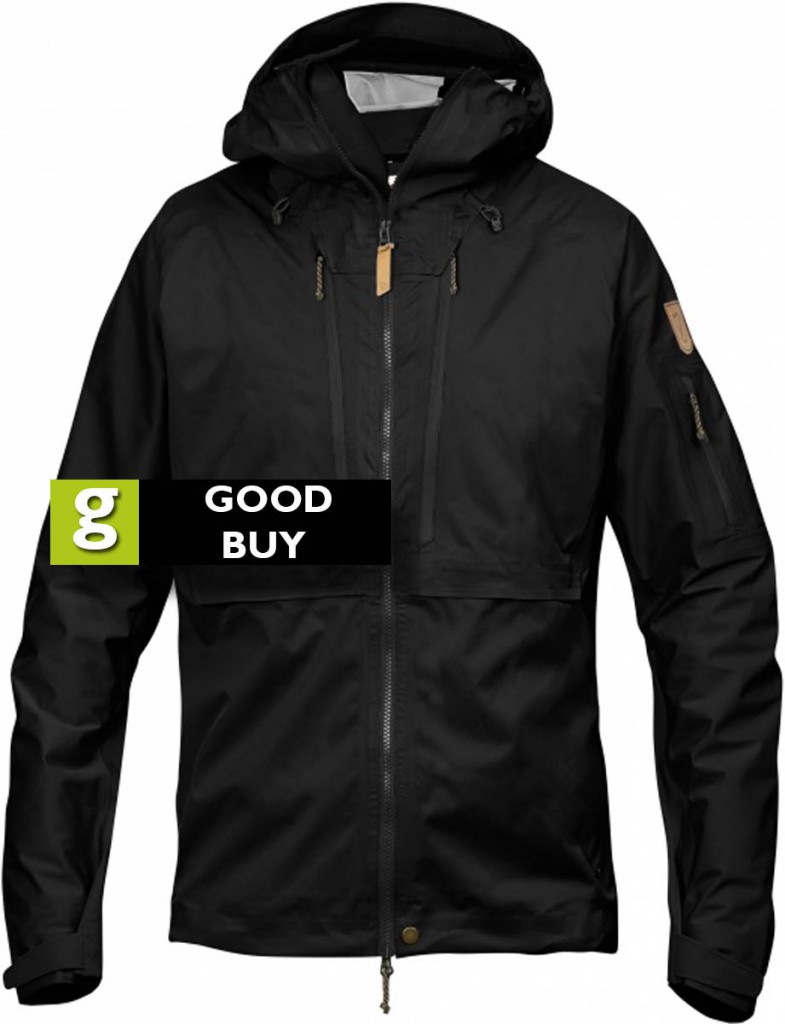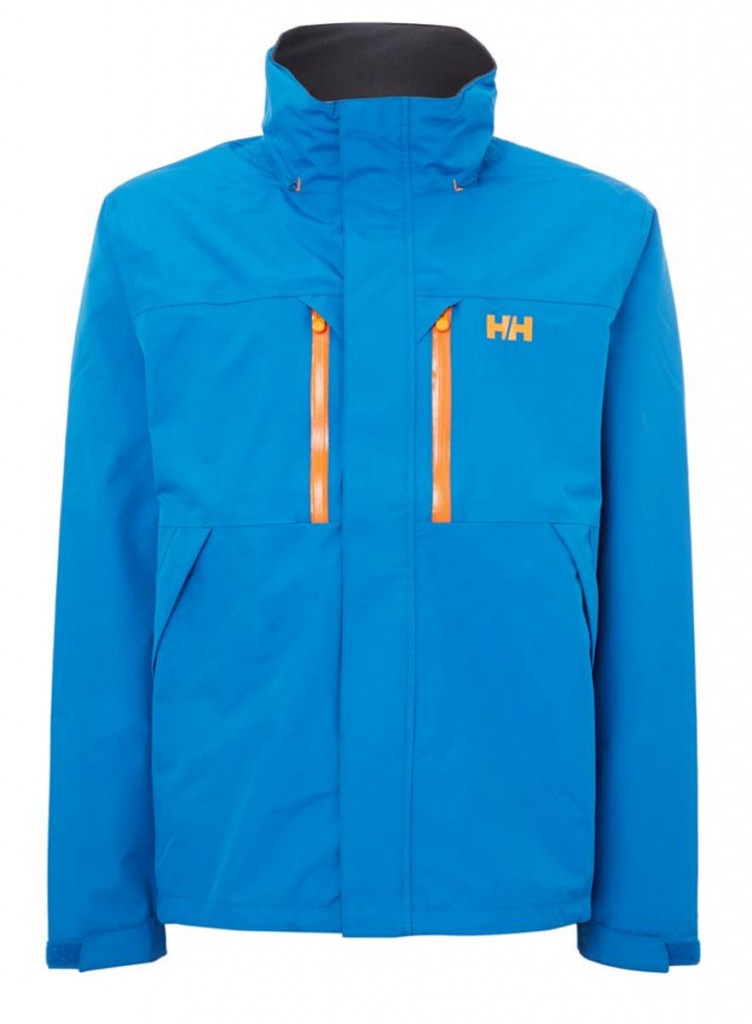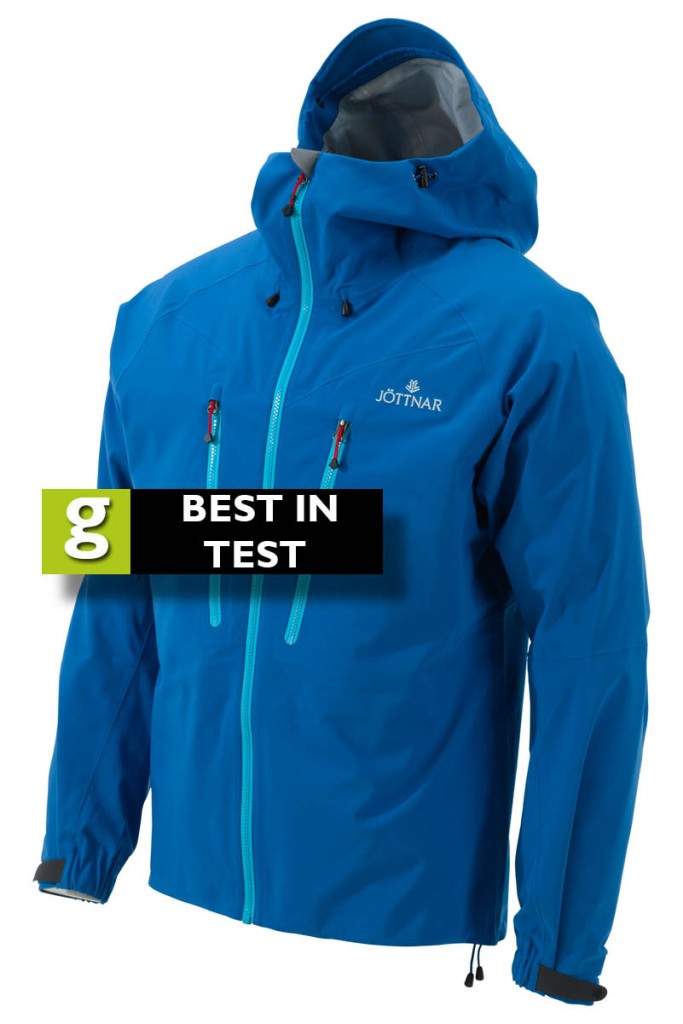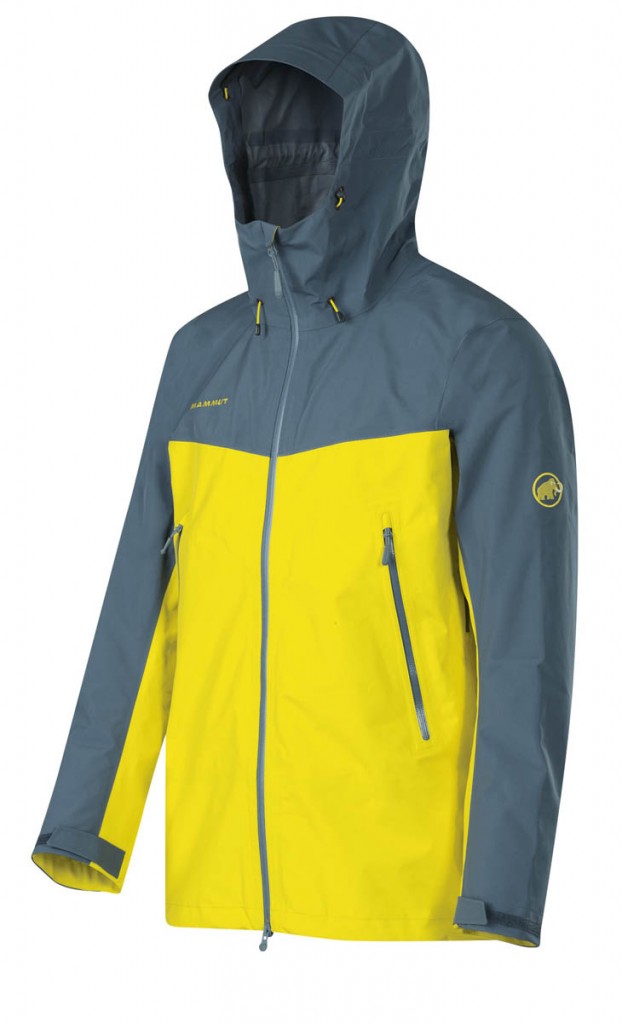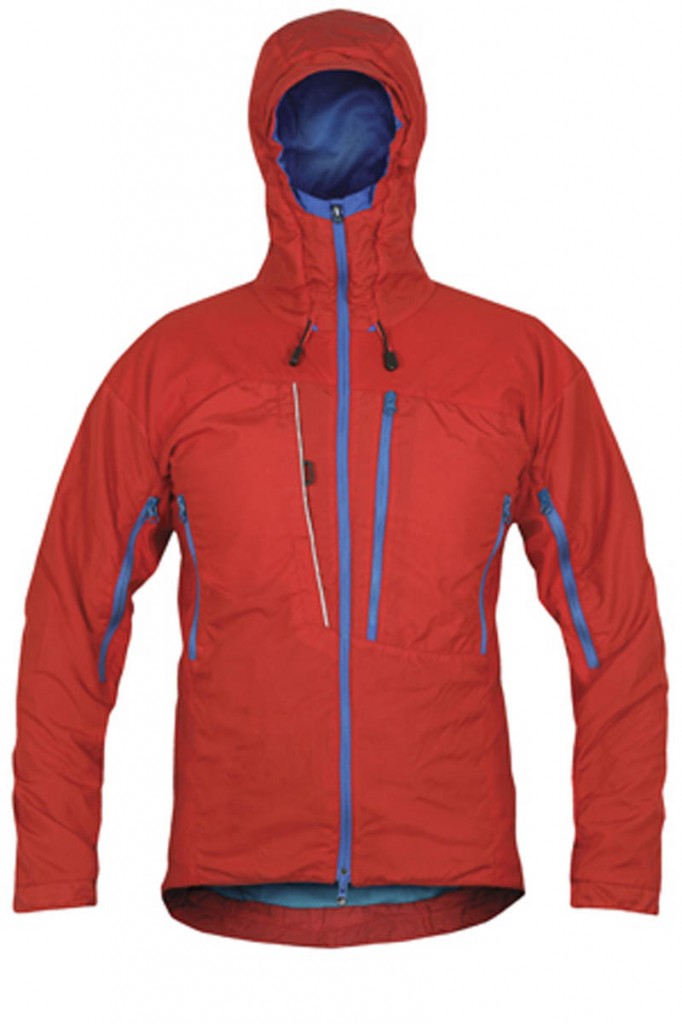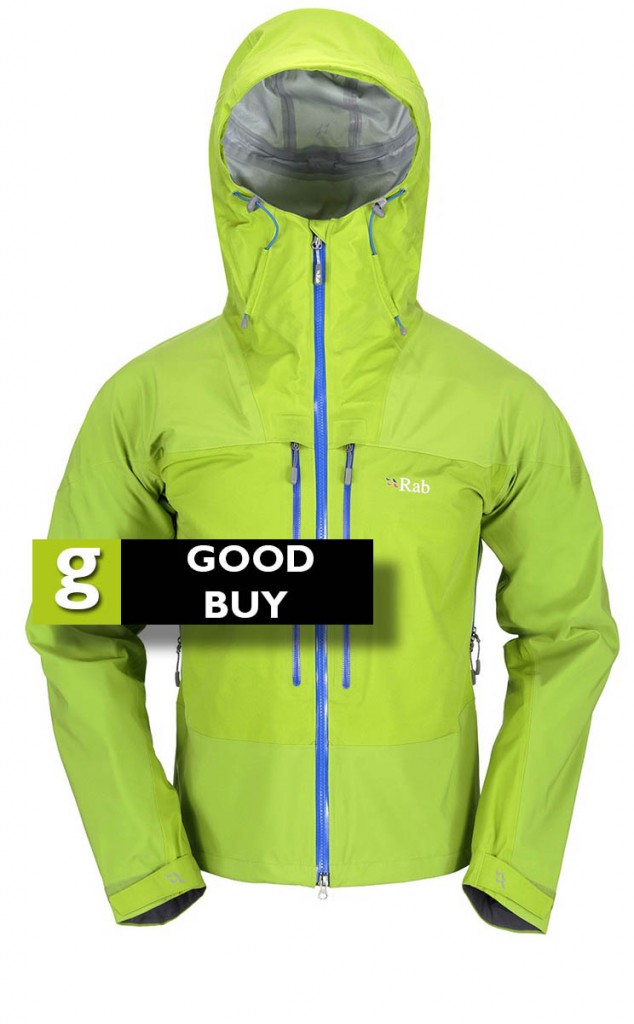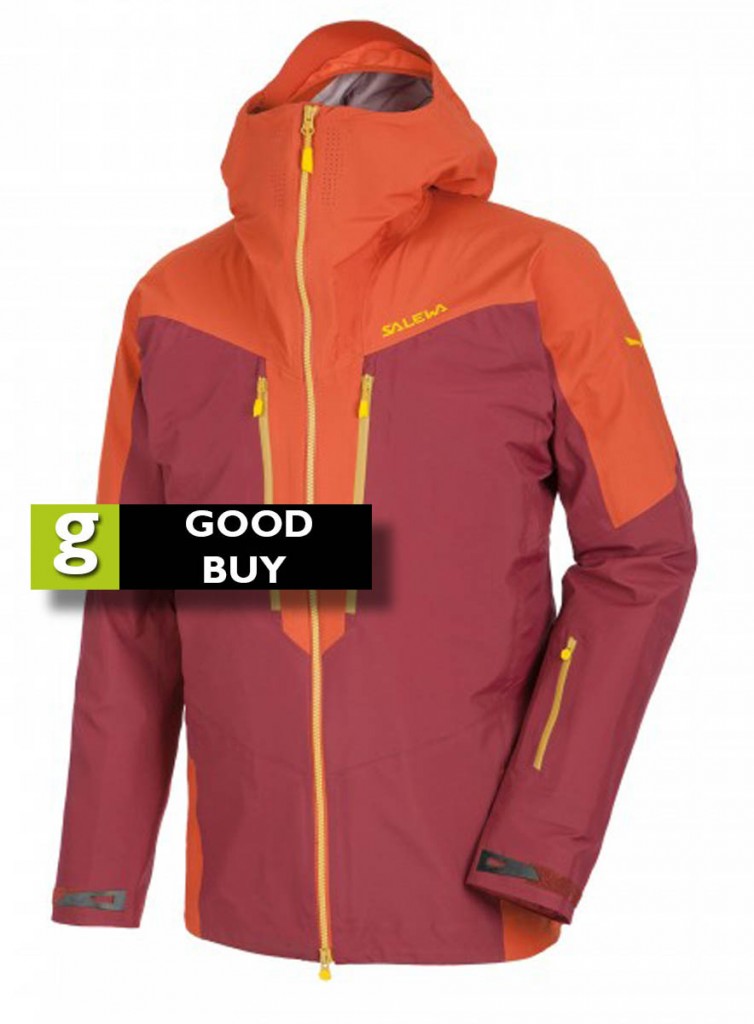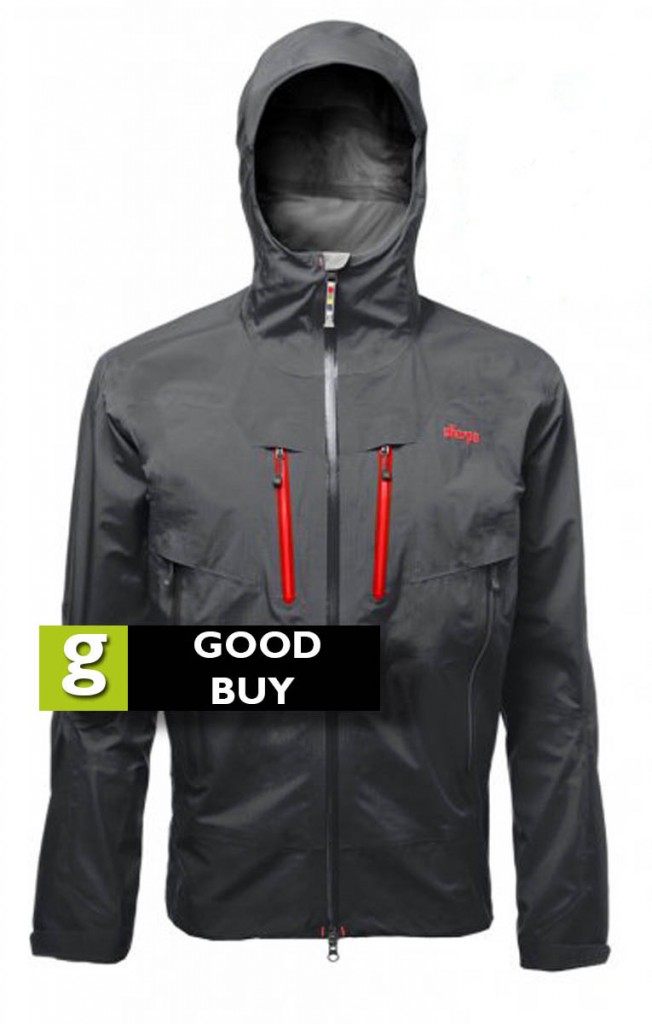A good waterproof jacket is your first line of defence against winter weather, and needs to keep out the rain, snow and wind as part the outermost part of your layering system to keep you warm as temperatures drop.
The jackets in this test use various means to keep the water out and, almost as important, shift the sweat away from your body.
Most use a membrane bonded to the main fabric and usually with a liner in a three-layer arrangement. The membranes, typically ePTFE or polyurethane, have a structure that keeps out rain and snow yet allows some of the moisture produced by the body to escape outwards, a process commonly known as breathability.
The face fabric is usually treated with a durable water-resistant finish that sheds raindrops in the familiar beading pattern. This can be reinvigorated after time by the use of proprietary chemicals and sometimes by heat from an iron or tumble drier.
The wetter the face fabric gets, the less easily vapour from the body can escape outwards, so waterproofs have to work hardest when you’re producing a lot of heat heading uphill in pouring rain – exactly when you need them most.
An alternative approach is that of Páramo, whose jackets have a tight-woven face fabric with a DWR treatment, combined with an inner ‘pump action’ lining that uses capillary action to move wetness outwards. Technically, they’re not waterproof in that they won’t withstand the pressure of a column of water that’s used to test fabrics, usually giving a ‘hydrostatic head’ of something between 10,000mm and 25,000mm.
But the Analogy system has its devotees who say that the Páramo jackets offer the most comfortable solution to the seemingly intractable desire to keep water out and let moisture escape.
Some of the jackets are expensive, but they need to be able to perform at the top end of the scale to protect the user from the worst weather winter’s likely to throw at you. They need to be tough, durable and comfortable, and to do this are likely to use quality materials and specifications.
We’ve been out on the hill extensively in these jackets. Here are our thoughts on all 10 winter waterproofs.
Berghaus High Trails Jacket
Colour: dark blue
Weight: 614g
Price: £220
Material: shell, polyamide with polyurethane membrane
Waterproofing: Three-layer Hydroshell Elite Pro
Country of manufacture: Thailand
Recommended wash: 30C non-biological powder
Sizes: S-XXL
Women’s version: no
The High Trails Jacket uses Berghaus’s own Hydroshell Elite Pro waterproof fabric, introduced in 2014, and aimed at the gap in the market between the extensively used Gore-Tex versions and less expensive systems.
The three-layer Elite Pro version of Hydroshell has good waterproofing figures: 20,000mm hydrostatic head, and breathability, at 20,000g/sq m/24 hours.
You get a lot of jacket for your money with the High Trails, which is very much a Berghaus bells and whistles garment. It was commented that it looks very traditional, which it is. The colour is muted; there are no contrasty zips, and styling is standard rather than athletic, though the jacket looks good on.
Sizing is reasonably generous, and the jacket is longer than some, aimed squarely at hillwalkers. There’s a rear dropped hem though, and the jacket is not that long that it restricts stepping up.
The jacket can also be used comfortably while wearing a climbing harness. The hood was big enough to accommodate a standard climbing helmet.
The High Trails has four zipped external pockets, all of which use storm flaps to help stop rain getting in. The lower two hip pockets are covered by a rucksack’s hipbelt or by a climbing harness, but the top two can still be used. All have cords on their zip pullers to aid use when wearing gloves.
All four of these pockets are big enough to take a laminated OS map.
There is also smaller pleated chest pocket with Velcro flap closing.
The main double zip of the jacket is protected by generous storm flaps kept in place by Velcro patches and by press-studs at the very top and bottom.
In use, these prevented driven rain getting past the zip.
Fully zipped up, the jacket covers the mouth but leaves the nose uncovered. The hood has a volume adjuster and also side adjustments. It worked reasonably well, turning partly with the head, and coped well with staying in position in a strong headwind. The spring toggles on the side adjusters are a little small to use easily when wearing gloves, though the rear volume adjuster was better.
The peak is wired for fine adjustment against driving rain and snow.
The articulated sleeves allowed free movement when reaching up, and the cuffs, which have Velcro adjusters, were wide enough to allow them to be closed over thick winter gloves.
The High Trails jacket is well thought out and performed well. The three-layer fabric is quite stiff, similar to some of the Gore-Tex models. Breathability was good and overall comfort was good when pushing hard.
Rather than pit zips, the High Trails has two body venting water-resistant zips at the side. These allow a little air flow at the core of the body, and are both protected by storm flaps, though opening any zips during heavy driven rain risks allowing water in. The only drawback we found of these compared to some pit zips is that they are slightly trickier to use because your rucksack harness crosses the path of the zip.
The jacket also has drawstring hem to help keep draughts out.
The Hydroshell waterproofing performed well and overall the jacket was quite comfortable. Breathability was good, and the Berghaus jacket provides good protection for hillwalkers at a reasonable price.
Waterproofness 26/30
Breathability 20/30
Comfort 3/5
Features 4/5
Quality 7/10
Value for money 17/20
Total score: 77/100
Black Diamond Sharp End Shell Jacket
Colour: blue
Weight: 454g
Price: £350
Material: 40D nylon three-layer shell with polyester microgrid backer
Waterproofing: Three-layer Gore-Tex Pro
Country of manufacture: China
Recommended wash: 40C
Sizes: XS-XL
Women’s version: yes
This Black Diamond jacket is a more minimalist design and is made from Gore-Tex Pro, the tough but very breathable fabric aimed at high-end users such as mountaineers, alpinists and climbers. But it also feels great as a bomb-proof protection for hillwalkers taking to the mountains in winter.
Despite being among the lightest of jackets on test, it feels robust, and the 40-denier nylon material stood up well during testing, though it is quite stiff and noisy.
In keeping with the minimalist design, the Sharp End’s main zip is a single one, and is backed by a single inner baffle. There are four pockets, two at chest level, clear of harness and hipbelt areas, and two hip pockets, which are covered by pack and harness belts.
The left chest pocket has an inner stretch mobile phone or MP3 player pocket, with inner cord exit. The chest pockets are fairly small; the hip ones bigger, and work well as handwarmer pockets. None of them are big enough to take a laminated OS map, though.
The chest pockets have large alloy zip pullers, as has the main jacket zip. The hip pockets have short cords and plastic tabs. All were usable with relative ease while wearing thick winter gloves.
The Sharp End is cut fairly short and didn’t restrict upward leg movement. Although it looks to be cut quite athletically, there was plenty of room for layers underneath and sizing was about average.
Design is very neat, and there’s an odd asymmetric panel at the top of the front of the jacket, sloping down from right to left, meaning the right-hand pocket zip sits slightly longer than the left.
Sleeves are articulated and have Velcro adjusters. The cuffs are big enough to allow winter gloves to be tucked in for walking.
The main zip covers the mouth when fully fastened, and there is soft chin guard lining. The hood has both a volume adjuster at the rear and side adjustment cords. These have integrated Cohaesive adjusters which work really well. The spring-loaded buttons, marked on the face fabric by the Cohaesive symbol, simply need squeezing to allow the cord to slide and slacken. The hem of the jacket also has Cohaesive adjusters, making for a neat set-up.
When cinched in, the volume adjuster and cords work well, with the hood turning with the head but the cord associated with them is fairly thinly sheathed and made for a less than comfortable feel across the forehead and cheeks when fastened closely in during a headwind.
The hood’s peak is stiffened rather than wired, but kept out the weather.
When pushing hard, the Black Diamond jacket provided very good breathability in heavy prolonged rain. The Sharp End has long double pit zips for ventilation, with the usual caveat that opening a jacket to any degree in driving rain or snow risks letting in the wet. The microgrid backing fabric felt comfortable in bad weather.
Quality of the jacket was excellent, and attention to detail in design and manufacture is what you would expect in a jacket at this price.
The Black Diamond Sharp Edge took everything the British weather could throw at it and we felt assured at all times in this robust yet lightweight jacket.
Waterproofness 27/30
Breathability 23/30
Comfort 4/5
Features 3/5
Quality 9/10
Value for money 14/20
Total score: 80/100
Fjällräven Keb Eco-Shell Jacket
Colour: black
Weight: 498g
Price: £390
Material: 100 per polyester
Waterproofing: Three-layer Eco-Shell
Country of manufacture: China
Recommended wash: 30C and re-impregnation with non-fluorocarbon proofer
Sizes: XXS-XL (women’s); XS to XXL (men’s)
Women’s version: yes
This is a true waterproof jacket from Swedish brand Fjällräven, using its new Eco-Shell laminate system.
It has nice neat, minimalist Scandinavian styling, with soft-feeling fabric, less rustly than many of the jackets in the test.
The Eco-Shell fabric, as well as being touted by Fjällräven as one of the outdoors industry’s greenest products, has impressive waterproofing and breathability figures, which were borne out in our test. In torrential driven rain the jacket kept out the water, even though the face fabric did wet out eventually.
Breathability was good, even in very wet weather.
There’s a very slight stretch to the fabric which aids mobility a little when reaching up. The main double zip has a baffle inside to help keep out the water, and the jacket has spring toggles at its hem to cinch it and keep out some of the upward draughts.
The jacket has two large exterior zipped chest pockets, each of which is big enough to take a laminated OS map. These also have a hidden, pleated bellow to increase capacity. Each also has an inner stretch mesh pocket, big enough for a smartphone or MP3 player. Both have cord exits internally. The Eco-Shell also has a medium-sized inner stretch mesh pocket, also zipped. There’s a tiny pocket in the bicep area of the left sleeve, big enough to fit a compass.
The chest pockets are clear of the area of rucksack hipbelts and harnesses, and there are no lower hip pockets. The jacket is tailored fairly long, but we managed to wear a climbing harness comfortably with it.
There are core ventilation zips either side of the torso area, both with double zip pullers to adjust how much ventilation you need, subject to our usual caveats about letting in the rain or snow if you go for maximum ventilation.
All the Fjällräven jacket’s zip pullers have good cords attached which enable them to be worked while wearing winter gloves. The top puller of the main zip has a nice leather strip attached to use when closing or opening.
The sleeves are articulated and don’t restrict movement when reaching for holds or heading over stiles. The cuffs, which have Velcro adjustment, are wide enough to go over winter gloves.
The hood is not huge, but it will take a standard climbing helmet. Volume adjustment is by a standard cord and spring toggle at the rear, and side adjustment uses hidden spring buttons which were fairly easy to use. When cinched, the hood worked quite well, turning with the head. The zip covers the mouth when fully closed, and the peak is stiffened.
The Fjällräven Eco-Shell jacket is a nicely understated piece of Scandinavian design that doesn’t immediately shout ‘mountains’ at you, so would be equally at home tootling round the High Street in town as well as that more elevated version in the Lake District.
Quality and design were good and, as ever, there’s a little Arctic fox symbol on the shoulder. And if environmental considerations are near the top of your list, this garment scores well.
Waterproofness 26/30
Breathability 24/30
Comfort 4/5
Features 3/5
Quality 9/10
Value for money 13/20
Total score: 79/100
Helly Hansen Bykle Jacket
Colour: blue
Weight: 558g
Price: £130
Material: polyester
Waterproofing: Two-layer Helly Tech Protection
Country of manufacture: China
Recommended wash: 40C
Sizes: S to XL
Women’s version: yes
The Bykle is a nice looking jacket, with good Scandinavian styling. Its polyester fabric is fairly soft, and the rustle factor is low.
The Helly Hansen jacket is shorter than some and fit well when wearing a climbing harness. Cut is normal rather than athletic.
The main single zip is shielded by front and rear storm flaps, and the outer flap has Velcro patches plus press studs at the top and bottom to keep it in place. The zip covers the mouth when fully closed, and there is a soft chin guard at the top which was comfortable in use.
The hem has a drawcord with spring toggles to help keep out those updraughts.
The two-layer Helly Tech fabric has a mesh lining in the main body of the jacket and solid lining in the sleeves. Breathability was moderate and there was a fair build-up of moisture inside the garment when working hard.
The mesh lining was less comfortable than the backings found in the more expensive jackets.
The sleeves are not articulated and are cut fairly short, which meant they tended to ride up when reaching for holds. There are Velcro fastenings but the cuffs are not very wide and we struggled to get them over winter gloves easily.
The Bykle has four external pockets. The zipped hip pockets are covered by a harness or rucksack hip belt, and are covered by a storm flap.
The chest pockets are smaller and have water-resistant zips. The lower pockets are just big enough to take a laminated OS map, but then the zip wouldn’t close, so they stuck out a little.
The collar of the jacket has a wide soft lining which adds to comfort, and the hood is a rollaway type which packs away into the collar, with a single Velcro patch fastening.
The hood is the worst design element of the Bykle jacket, and we found it an irritation in driving rain.
It has no volume adjuster, which means the only way to cinch it to keep out the rain is to use the two side cords to pull it in to the face, and its locking slides are fiddly to use. The problem is, with the hood pulled close in, the soft, unwired peak comes right down and obstructs visibility. Constant pushing back of the hood was necessary to see where you were going; that, or loosen it and risk letting in the rain.
It is big enough to use while wearing our standard climbing helmet. In fact, it worked better with a helmet as this filled the volume of the hood and lessened the necessity to push it back repeatedly. A good hood is essential in winter conditions, and the Bykle’s wasn’t really up to the job.
The Helly Hansen jacket has good green credentials, and is bluesign approved.
Though the Bykle is the least expensive of all the jackets, and benefits from a nice looking Scandinavian design, it is less breathable and therefore comfort is likely to be compromised when working hard in cold, wet conditions. It’s more at home in less severe weather – an everyday coat for more moderate weather.
Waterproofness 22/30
Breathability 15/30
Comfort 2/5
Features 3/5
Quality 6/10
Value for money 14/20
Total score: 62/100
Jöttnar Bergelmir Jacket
Colour: blue
Weight: 500g
Price: £450
Material: nylon face and backing
Waterproofing: Three-layer Polartec NeoShell
Country of manufacture: China
Recommended wash: 40C
Sizes: S-XL
Women’s version: no
Jöttnar is a fairly new brand to the outdoor market and, despite its Scandinavian-sounding name, is British based.
Its range is small, but aimed at the top end of the market and the Bergelmir is its flagship waterproof jacket, with a price tag to match.
So what do you get for your money in this technical garment? Its design is the opposite of bells and whistles, with a minimalist but competent approach to keeping you dry in extreme conditions.
The Bergelmir is cut athletically, but is quite generously sized. The upper chest area and shoulders in particular are anything but tight, so if you are very muscular in that area, you should have no problems. There’s room for layers or insulation under the jacket.
It’s cut quite short, with technical activity in mind, but we found it worked well for hillwalking too, with no restriction of movement when stepping up. The rear has a drop hem.
Design is simple but effective: there are just two exterior pockets at chest level, protected by water-resistant zips. These are well clear of the hip-belt or harness area, and are also big enough each to take a laminated OS map.
Inside, there are two smaller, interior, zipped pockets, each big enough to take a smartphone.
There are no pit zips or torso zips. Jöttnar reckons that, because the Polartec NeoShell fabric is so breathable, this ventilation would be superfluous. Given that such vents are an obvious potential entry for rain and snow, we don’t think their omission is anything untoward.
The fabric is nylon, but is not as rustly as some of the other nylon-faced jackets and in fact feels almost softshell-like. The nylon material should be tough in the long term, with good abrasion resistance.
Zip pulls have cord extensions that end in little plastic tabs, and all could be operated easily while wearing winter gloves.
The hem cords of the jacket have separate front and back section, each threaded through a spring toggle. This means, as well as being able to be tensioned separately front and back, they don’t create a loop at the toggle, reducing the risk of snagging on gear or rock or other features.
The hood is good, and performed well both when wearing a helmet and without. It has a conventional rear volume adjuster and two side adjusters, and a fairly large stiffened and wired peak. The hood was comfortable even when pulled close in and the peak worked well in headwinds. The side cords’ spring toggles are fairly small, as with most hoods, and defeated our efforts to slacken when wearing thick gloves, but the volume adjuster has a larger spring toggle that was easier to adjust.
The chin protection, though fairly thin, was comfortable.
The Bergelmir’s sleeves are articulated and allowed easy movement when reaching up for holds. They’re quite long too, so don’t ride up the arm when it’s fully extended. Wrist closure is a combination of a wide elasticated section round half of the sleeve, and a Velcro and Hypalon tab, which together mean you can get a very snug yet comfortable seal around the wrist.
NeoShell’s waterproofness is rated at 10,000mm hydrostatic head, which is not as high as some waterproof fabrics which use ePTFE membranes, but that figure is high enough to keep out wind-driven rain and snow, which the Bergelmir did. NeoShell is constructed with a polyurethane membrane made in a different manner from most others in use in the outdoors, and benefits from good moisture transfer – breathability in ordinary parlance – and the Jöttnar jacket did very well when pushed hard uphill in the wet. Build-up of moisture on the inside of the garment was low.
It’s only when you look carefully at the Bergelmir that you start to see some justification in its high price. You’re not paying for extra pockets, or fancy venting systems. Materials are high quality and manufacturing standards are very good. The face fabric feels robust but is still fairly lightweight. Overall, the Jöttnar jacket just says excellent quality.
That said, the Bergelmir is expensive. But we think it will give long service. If high performance is your goal and you spend a lot of time on the hill, that investment may pay off.
Waterproofness 26/30
Breathability 25/30
Comfort 4/5
Features 3/5
Quality 9/10
Value for money 13/20
Total score: 80/100
Mammut Crater Jacket
Colour: yellow/grey
Weight: 540g
Price: £270
Material: polyester face and backing
Waterproofing: Three-layer Gore-Tex
Country of manufacture: China
Recommended wash: 30C then iron
Sizes: S-XXL
Women’s version: no
The Mammut Crater uses Gore-Tex waterproofing with a polyester face material and lining. It’s surprisingly stiff and noisy for a polyester jacket, but gave a reassuringly solid feel and kept out the rain well.
The Crater is cut conventionally, and is fairly long, with a rear drop hem. As with some other Mammut garments we’ve tested, sizing is on the snug side, perhaps a half size smaller than some brands of the equivalent size, worth bearing in mind when buying.
The jacket’s main, double zip is water resistant and is also backed by a storm baffle. Only the upper zip puller has a cord extension and tab for easy use with gloves.
The Mammut jacket has two external chest pockets, with water-resistant zips. These sit clear of the harness and hip-belt area and are just big enough to take a laminated OS map. The Crater also has a single, zipped, stretch mesh pocket, big enough to take a smartphone.
The external pocket zips have short cords with tabs which were easy to use with winter gloves.
The jacket has double water-resistant pit zips, with both pullers having cords and tabs. The sleeves aren’t articulated but didn’t restrict movement to any degree. Cuff adjustment is by Velcro tabs and the sleeves will fit over winter gloves, even though the cuff isn’t as wide as some jackets.
Hem adjustment of the jacket is by drawcords and spring toggles.
The hood has a rear volume adjuster and side cords to cinch in against the wind. The hood worked well and turned with the head, though the material, as with the jacket, is quite stiff. Fully zipped, the jacket half covers the mouth. There is a chin protector strip but it’s not that comfortable. The hood accommodated a standard climbing helmet.
The breathability of standard Gore-Tex is not rated as highly as the Pro version, but the Crater actually performed quite well when we pushed hard, and there was little build-up of moisture.
The Mammut Crater is a competent jacket at a reasonable price that kept out the rain and had good breathability.
Waterproofness 26/30
Breathability 22/30
Comfort 3/5
Features 3/5
Quality 7/10
Value for money 15/20
Total score: 76/100
Páramo Enduro Jacket
Colour: red
Weight: 802g
Price: £370
Material: polyester
Waterproofing: Nikwax Analogy
Country of manufacture: Colombia
Recommended wash: 40C Nikwax Tech-Wash
Sizes: XS-XL
Women’s version: no
And now, for something completely different.
All the other waterproof jackets in this test rely on their ability to keep out rain and snow by a combination of durable water-repellent treatments of the outer fabrics and a membrane that lets water vapour away while keeping out rain droplets.
The idea is to keep you dry and comfortable but the problem is dealing with the sweat we produce while doing those strenuous things such as walking up a hill. Páramo takes a different approach, and with that has attained something akin to cult status among devotees. Yet others dislike its waterproofs with a similar enthusiasm.
So how well does the Páramo Enduro Jacket work? The first two things to note are its weight and softness. At more than 800g, the jacket weighs almost twice as much as the lightest in the test. It is thicker and much softer. There is no crinkliness and noise from the Enduro that might be expected with some others in the test.
And because it is considerably thicker than the other shell jackets, it’s instantly warmer – no bad thing in a winter jacket. The soft polyester fabric of the Enduro won’t give you that crisp look that a neatly designed shell jacket might, but this is nonetheless a modern-cut and, we think, quite attractive top that denotes the wearer as an active outdoors type. Páramo jackets in the past could be viewed as a little frumpy in their design, but this top-of-the-range Enduro is athletically cut, is short to allow for easy stepping up and has funky contrasting zips.
The main double zip is protected at the rear by a storm flap and has press-studs top and bottom. The top puller has a plastic tab extension that made it easy to use while wearing winter gloves. The jacket’s hem, which is scooped at the rear, has drawcords which can be released by a pair of concealed spring buttons.
The Páramo jacket has two zipped handwarmer pockets high on the side of the jacket, both of which clear, just, the harness and rucksack hipbelt area. There is another zipped chest pocket on the left, which is just big enough to take a laminated OS map. A smaller chest pocket on the other side is a ‘quick access’ one, with a full-length Velcro strip with a large plastic tab for unfastening. This was easy to use with gloves on. The other zips, apart from the main one, only have small plastic extenders, but we did manage to use them while wearing gloves without too much difficulty.
There is a small, zipped, inner pocket made of thick mesh, which is big enough to take a smartphone.
There are shortish pit zips to help ventilation and the jacket has stretchier panels on the shoulders, sleeves and sides which make for very good and comfortable movement. The cuffs have hook and loop adjusters which work in the opposite direction to all others we’ve tried, fastening on the outer side of the wrist rather than the inner. Odd at first, but soon got used to.
The hood has a wired peak and good volume adjustment at the rear, with an upper spring toggle and a lower concealed spring button. Side adjustment is by drawcords and embedded spring buttons which were much easier to use than fiddly little toggles. The hood will accommodate a standard climbing helmet and is comfortable in use, due to the softness of the fabric.
It does turn with the head when cinched in, although vision sideways was slightly impaired by the depth of the hood. There is no chinguard on the top of the zip, so when fully fastened with the hood tightened, the top press-stud can be felt against the face. Addition of a chinguard would definitely improve comfort.
But does the Enduro jacket keep you dry? Technically, because it won’t withstand penetration of a column of water under pressure, it’s not classed as waterproof. The Páramo Analogy system relies first of all on a durable water repellent coating on the face fabric, and this worked well, beading raindrops consistently. It can be retreated using associated company Nikwax’s solutions.
At the heart of Páramo’s Enduro is the directional technology with a pump-liner that draws moisture away from the body and pushes it outwards. Combined with the repellency of the outer fabric, this provides comfort by cutting the amount of sweat build up and that horrible clamminess when you stop and start to cool down.
Páramo says its Enduro will withstand at least four hours of steady rain. That sounds about right in our experience. Over two or three hours, the jacket kept out the rain. In heavy, prolonged, wind-driven rain on the hill, we felt some dampness where the rucksack compressed the jacket, on the shoulders and the hipbelt.
Even so, reasonable comfort was maintained as the lining, mesh patterned in the torso and back areas, shifted moisture outwards and helped keep body temperature up.
So we’re not going to join the Páramo adoration cult, but neither are we dismissing the system. In cold, wet conditions the Enduro jacket kept us comfortable and largely dry. Its ability to shift sweat was impressive, which is important when working hard uphill, and its cut and design bring it up-to-date for active outdoor users.
Its added thickness and warmth makes it a good choice for days on the mountain when a little extra protection comes in useful, but the Enduro is probably a little on the warm side for use on hot summer days.
Páramo’s ethical credentials are good. The jacket is a product of the Miquelina Foundation in Bogotá, Colombia; its Nikwax treatment eschews perfluorinated compounds, over which there are environmental and health questions, and the Enduro jacket can be recycled with Páramo in return for a voucher off new gear from the brand.
Waterproofness 20/30
Breathability 26/30
Comfort 5/5
Features 4/5
Quality 8/10
Value for money 15/20
Total score: 78/100
Rab Neo Guide Jacket
Colour: green
Weight: 528g
Price: £300
Material: polyester
Waterproofing: Polartec NeoShell
Country of manufacture: China
Recommended wash: 30C
Sizes: S-XXL
The Rab Neo Guide is one of the brand’s high-end jackets that uses Polartec NeoShell in its construction, and it was Polartec that provided our sample.
There is a slight stretch in the material, and the Neo Guide is tailored for a conventional fit and its sizing is about the norm, which means there is room to wear a thin insulated garment or layers under it.
The fabric feels quite soft, and its rustle factor is low. The jacket is nicely styled, with contrasting zips and a fairly minimalist design. The double, water-resistant main zip has a rear storm flap and press-stud on the bottom hem. The top zip puller has a cord extension that made it easy to open and close while wearing gloves.
There are two good-sized chest pockets, clear of both the climbing harness and pack hip-belt areas. Both have water-resistant zips with cord extensions on the pullers. Both pockets are big enough to take a laminated OS map.
Inside the jacket is a medium-sized, zipped mesh pocket, easily big enough to accommodate smartphones and other electronic gadgets. On the other side is another internal pocket, this time a stretch, open, mesh version that will hold a small drinks bottle.
The jacket has thicker panels at the shoulder, elbow and hip areas where wear is likely to be maximised. There are long pit zips with double, water-resistant zips and cord extensions on the pullers.
Sleeves are articulated and allowed good movement without riding up the arms. Thanks to its cut and the slight stretchiness of the NeoShell, the jacket allowed for good, unrestricted movement overall. The jacket hem has drawcord adjustment with spring toggles.
Sleeve cuffs have Velcro adjustment and are just about wide enough to allow them to overlap winter gloves. The cuffs have a soft fabric lining.
The hood was big enough to use with a standard climbing helmet and has volume adjustment via a rear cord with spring toggle, plus side adjustment with separate tethered cords again with spring toggles. It worked well both with and without helmet, turning with the head. There are chin guards to aid comfort when the zip if fully closed.
NeoShell has a waterproof rating of 10,000mm and the Neo Guide kept the rain out while we were on the hill. Breathability was good too, with little build-up of sweat.
This made for a comfortable experience in the Rab jacket. The brand says this jacket is ideal for Scottish winter outings and Alpine conditions. Its performance backs this up, with comfort maintained even when working hard on ascents. The Rab NeoGuide feels like a waterproof designed with the UK’s mountains in mind, and it made for a comfortable winter hillwalking experience.
Waterproofness 26/30
Breathability 25/30
Comfort 4/5
Features 3/5
Quality 7/10
Value for money 14/20
Total score: 79/100
Salewa Antelao Jacket
Colour: red/dark red
Weight: 454g
Price: £375
Material: nylon
Waterproofing: Three-layer Gore-Tex with C-Knit Backer
Country of manufacture: Vietnam
Recommended wash: 30C; reproof when face fabric fails to bead water
Sizes: men’s S-XXXL’ women’s 6-14
Women’s version: yes
This jacket was actually picked up during a presentation in Italy by Gore-Tex of its new fabric, the clumsily titled Gore-Tex with C-Knit Backer.
This is a development of the company’s general purpose Gore-Tex, with the addition of a very smooth backing fabric which, on close inspection, has a tiny circular pattern. It is this, along with a new laminating process that involves fewer glue dots, that gives a claimed 15 per cent increase in breathability.
The fabric is firmly aimed at the hillwalker and is appearing in lots of top brands and in this instance is used in this Salewa garment, a brand based just down the road from the launch in the South Tyrol.
This jacket is actually designed for ski mountaineering, but if it’s good enough for skimo-ers, it should do the job for walkers too. The first test was a trail walk in the snow with an ascent of 3,000ft and the jacket performed well. With that sort of trog, some moisture is inevitable but the build-up inside the Antelao was minimal and it soon cleared once the ascent was finished.
Back in the UK, in wet, cool conditions, the new Gore-Tex kept the moisture under control and there was only a small amount of condensation on the inside of the jacket at the top of our test route ascent. The backing material is very smooth and comfort was good, so the C-Knit Backer does seem to do the job.
Compared to conventional Gore-Tex backing, it’s lighter and less stiff too, but the Salewa jacket felt tough. It has reinforced rip-stop areas on the face fabric in the shoulder, backside and hood areas.
The Antelao was the longest jacket in the test and has an athletic fit. It was still possible to use a climbing harness with the Salewa jacket, and the two chest pockets, which have water-resistant zips, sit clear of the harness and hip-belt area.
The main double zip has a storm flap behind it, and the top puller has a cord extension which helped adjustment while wearing gloves. The pocket zip pullers also have cord extensions, as do the single zips on the short pit zips, which are set well back on the sleeves so are more sleeve zips than pit zips. These zips are clear of the rucksack harness area.
The sleeves are quite long but and are articulated and allow easy reaching up for holds. The cuffs are good and wide which makes overlapping gloves easier. Adjustment is by a Velcro strip. The left sleeve has a small zipped pocket on the just above the wrist.
There’s a slight stretch in the material and the jacket is cut nicely to allow free movement. Inside the jacket is an open stretch mesh pocket, big enough to take a drinks bottle and with a rubberised lip to help keep it in place. A second stretch mesh pocket is big enough to take a smartphone.
The jacket’s hem is adjusted by drawcords with hidden spring buttons.
The Antelao’s hood worked well and accommodated a standard climbing helmet. It has a lower rear elasticated section which doubles as a sort of rear neck gaiter when the hood is down, keeping out draughts. With the hood up, adjustment is by a single volume adjuster which sits fairly high on the rear of the head.
Despite not having side vertical adjustment, the cinched in hood sits snug against the cheeks and kept out the rain. A stretch internal gaiter that sits across the forehead also helps keep wind and rain out, and the peak is slightly stiffened.
The jacket comes quite high on the face when fully zipped, covering both mouth and nose if desired with the hood up. There are laser-cut vent holes in the chinguard, which is not very well padded but was reasonably comfortable. These allow for some breathing ventilation, handy in very cold weather walking into a headwind, but when working hard uphill, we preferred to tuck the jacket under the chin to allow maximum air to the mouth.
The new Gore-Tex with C-Knit Backer is a nice fabric, less rustly and stiff and with a very good smooth feel inside. We did detect an improvement in breathability over standard Gore-Tex too. The Antelao is a quality jacket with some nice design features and quality manufacture. It felt robust too despite being the joint second lightest in the test.
It’s a good length too, which makes it a great choice for hillwalking, if ski-mountaineering is not your thing.
Waterproofness 27/30
Breathability 23/30
Comfort 4/5
Features 4/5
Quality 8/10
Value for money 13/20
Total score: 79/100
Sherpa Adventure Gear Lakpa Rita Jacket
Colour: black
Weight: 446g
Price: £280
Material: nylon
Waterproofing: Three-layer eVent
Country of manufacture: Nepal
Recommended wash: 30C
Sizes: men’s S-XXL’ women’s XS-XL
Women’s version: yes
The Lakpa Rita, named after the first Sherpa to climb the seven continents’ highest mountains, uses eVent for its waterproofing. This works in a similar way to Gore-Tex, with an ePTFE membrane but its composition is different and should allow better moisture transfer.
The downside is that it may need more frequent washing to keep its properties in tip-top condition.
The Sherpa jacket has some panels made from ripstop nylon in high-wear areas and nylon taffeta fabric in other parts. The fabric is a little rustly, but not too stiff.
The Lakpa Rita is fairly long and is cut athletically. The main double zip has a long tag on its top puller which made using it while wearing gloves easy. The rear has a drop hem. A drawcord, with conventional spring toggles, allows the hem to be cinched in to keep out draughts. Sizing of the garment is about average.
Mobility was good and allowed reaching up for holds, helped by the medium-length articulated sleeves. Wrist adjustment was by Velcro strips, though the cuffs are not very wide so getting them over big winter gloves was a struggle.
The jacket is fairly minimalist in design: there are no pit zips, but it does have two lower handwarmer pockets which are in the harness or hipbelt area, so it’s a squeeze to access them if you’re wearing either, as well as two chest pockets which are clear of this area. All four have water-resistant zips with puller extensions. The top two are in a contrast colour.
The two chest pockets are quite small, big enough for a smartphone, and one has a cord exit into the inside of the garment, but the two lower ones are big enough to take a laminated OS map.
The hood will accommodate a standard climbing helmet and has just a volume adjuster at the rear, with no side drawcords. Despite this, it sits fairly snugly around the face when tightened. The peak is stiffened and also wired, and the wiring can be shaped around the temples of the head to help keep wind out.
The hood turned quite well with the head, though the material is fairly stiff. When fully zipped with the hood up, the jacket comes just to the bottom of the mouth, so doesn’t protect that well against freezing winds, though it does leave the mouth clear for hard breathing when working uphill. There is a fairly thin chin guard, though it was reasonably comfortable.
Breathability was good when pushing hard uphill and once the strenuous eased, moisture inside the jacket dissipated. The Lakpa Rita is a tough feeling jacket despite its place as the lightest in the test, and coped with poor conditions admirably.
Waterproofness 27/30
Breathability 23/30
Comfort 3/5
Features 3/5
Quality 7/10
Value for money 16/20
Total score: 79/100
The two stand-out performers were the Black Diamond Sharp Edge and the Jöttnar Bergelmir, both of which were high quality jackets clearly aimed at people undertaking serious winter trips into the hills.
A clutch of brands was hard on their heels, with the Fjällräven Eco Shell, Rab Neo Guide, Salewa Antelao and Sherpa Adventure Gear Lakpa Rita all performing well and each with their own strengths.
If you buy into the Páramo system, the Enduro jacket was the most comfortable overall, but also the heaviest and warmest.
The Páramo and Fjällräven jackets had the strongest green credentials, a factor that is likely to increase in importance in the future.
The Berghaus High Trails was a good value jacket that performed well for its price, and the brand’s Hydroshell waterproofing sits well in that upper mid-range bracket.
Best in test: Black Diamond Sharp Edge, Jöttnar Bergelmir
Recommended: Fjällräven Eco Shell, Rab Neo Guide, Salewa Antelao, Sherpa Adventure Gear Lakpa Rita
Good value: Berghaus High Trails
